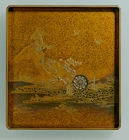Japanese Gallery (Honkan) Room 14
March 17, 2009 (Tue) - May 31, 2009 (Sun)
Writing boxes were used to store writing equipment, a set of which traditionally included an ink stone, a water dropper, brushes, an ink cake and a knife. Indispensable in daily life, writing boxes were always kept at hand in the living quarters of literate households. Along with cosmetics boxes, which contained toiletries and other personal articles, writing boxes were standard functional household items which also served a decorative purpose. Most extant maki-e lacquerware masterpieces from the middle ages are in fact either cosmetics boxes or writing boxes, and it was most probably their decorative role which led to them becoming representative of the maki- e lacquerware genre.
In pre-modern times, writing boxes were the primary vehicles for expression of maki-e techniques. When artists such as Hon'ami Koetsu, Ogata Korin and Ogawa Haritsu emerged in the Edo period (1603-1868), they fathered a rich variety of writing boxes which differed from conventional maki-e work to embody the novel and unique styles of their creators. Informed by the objets' function, the designs which decorated writing boxes often featured poetry and other literary works.
This exhibition showcases the minute detail of maki-e decoration, while highlighting the diversity of styles among writing boxes and drawing attention to their depiction in paintings. We hope this exhibition provides viewers with a deeper understanding of the breadth of styles found among writing boxes, and the role they played in traditional daily life.

